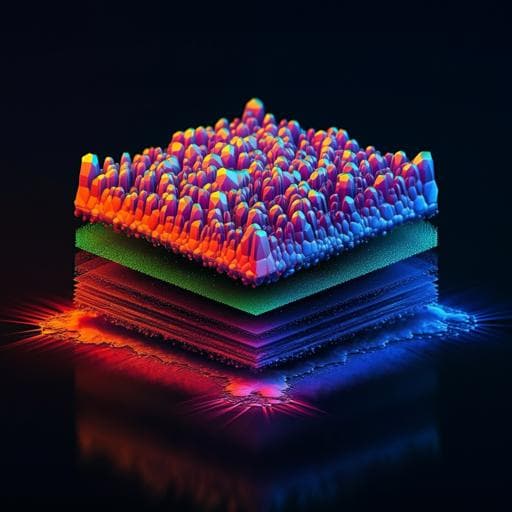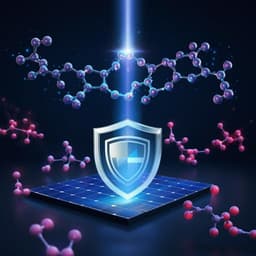
Physics
A high-efficiency programmable modulator for extreme ultraviolet light with nanometre feature size based on an electronic phase transition
I. Vaskivskyi, A. Mraz, et al.
Discover a groundbreaking method for a high-efficiency programmable modulator for extreme ultraviolet and soft X-ray light, developed by Igor Vaskivskyi and team. This innovative approach utilizes a holographic mask imprinted in a unique material, achieving remarkable efficiency while allowing programmability across wavelengths.
~3 min • Beginner • English
Introduction
The work addresses the challenge of manipulating EUV and X-ray beams, where conventional optical modulators are ineffective or technologically complex. Existing approaches, such as lithographically etched transmission gratings and multilayer blazed gratings, operate over narrow spectral ranges and require precise fabrication. Mechanical modulation is slow and constrained, while recent MEMS devices and phase-change-material-based reflective SLMs face limitations in beam footprint, synchrony with sources, and feature size due to thermal switching. The authors propose and demonstrate a reflective, programmable modulator for EUV/soft X-ray light based on ultrafast imprinting of a periodic structure in 1T-TaS2 via a phase transition between metastable electronically ordered states. This approach aims to achieve sub-90-nm feature size, fast write/erase capability, stability at low temperature, and high diffraction efficiency tunable across wavelengths.
Literature Review
Prior work on EUV/X-ray diffraction gratings includes lithographic etching of thin-film transmission gratings and multilayer blazed gratings, which offer limited bandwidth and require complex fabrication (refs. 1–2). Temporal modulation is often mechanical, with limited speed and precision, although a MEMS approach has demonstrated 350 MHz modulation, with constraints on beam footprint and synchronization (ref. 3). A reflective SLM based on the phase-change material Ge2Sb2Te5 showed fast writing and stability but was limited by thermal propagation leading to large feature sizes (ref. 4). Transient grating methods using visible/IR pulses are widely used to probe thermal, acoustic, and carrier dynamics (refs. 6–18). EUV transient gratings at FELs have been demonstrated (refs. 19–21), but these are typically short-lived (up to nanoseconds) due to diffusion and recombination. The layered material 1T-TaS2 exhibits thermally driven transitions between incommensurate (IC), nearly commensurate (NC), and commensurate (C) CDW states and supports photoinduced metastable states (H and A) with tunable lifetimes (refs. 22–24, 27–32), including large, hysteretic out-of-plane lattice changes across NC–C (ref. 22), providing a mechanism for high-efficiency diffraction via lattice modulation.
Methodology
Materials: Single-crystalline 1T-TaS2 was grown by chemical vapour transport (iodine transport agent), exfoliated, and inserted into vacuum to avoid oxidation. Quality was confirmed by X-ray diffraction; initial characterization by DC transport.
Experimental setup: EUV transient grating experiments were performed at the EIS-TIMER beamline, FERMI FEL (Trieste), in backward diffraction geometry. ~50 fs FEL pulses were split into two pump beams (write beams) and one probe beam via wavefront-division beam splitters. After spectral filtering, beams were overlapped and focused on the sample mounted on a cold-finger cryostat. Pump wavelength λpump = 39.9 nm (photon energy 31.1 eV), probe λprobe = 13.3 nm (93.3 eV, non-resonant). The angle between pump beams was 27.6°, producing an interference pattern with 87 nm period on the sample surface. The diffracted probe intensity was recorded on a CCD as a function of pump–probe delay (stroboscopic acquisition). For metastable low-temperature studies, the sample received a single train of ~50 pump pulses (~1 s illumination), then the probe alone monitored slow dynamics. Incident fluences: pump 3.8 mJ cm^-2 per beam; probe 3.5 mJ cm^-2. Bright fringe fluence at low T reached ~15.2 mJ cm^-2. Temperatures: room temperature (NC state) and 100 K (C ground state).
Electronic transitions: Pump energy near Ta O3 (5p3/2, 34.7 eV), N4,5 (4f5/2, 25.5 eV; 4f7/2, 23.6 eV) to Ta 5d states; probe non-resonant with ~3× longer absorption length to avoid disturbing the grating.
Data analysis: Room-temperature diffracted intensity I_TG(t) was modeled as a sum of an exponential background and two damped oscillators with a finite rise time, assuming instantaneous excitation (Heaviside step). Fit parameters include amplitudes, frequencies, phases, damping constants, relaxation times, and rise time.
Write/erase protocol: At 100 K, crossed pump beams imprint a periodic metastable electronic and lattice modulation (C/H or C/A domain structure). Erasure was tested by illuminating with a single EUV pump beam (no interference), acting as a heating beam; dynamics were monitored by the probe.
Key Findings
- At room temperature (NC state), the EUV transient grating produces a diffracted probe signal comprising an exponential background with superimposed oscillations due to acoustic modes. Rise time: 5.2 ± 1 ps (electron–lattice thermalization). The signal decays within ~200 ps due to thermal equilibration between bright and dark fringes. Oscillation frequencies correspond to a surface acoustic wave (near TA phonon) and a surface-skimming longitudinal mode (near LA phonon), consistent with neutron phonon data.
- At 100 K (C state), crossed EUV pumps imprint a persistent periodic structure: strong diffraction appears at the grating wavevector and remains nearly constant after pumps are blocked, persisting for at least 750 s. The structure can be erased by a single EUV pump beam with an exponential decay time constant of 48 ± 3 s, after which the process is repeatable without surface degradation.
- The persistent diffraction arises from a photoinduced transition to metastable hidden electronic order, producing periodic modulation of the out-of-plane lattice parameter (real-space sinusoidal reflective grating). The effect leverages the ~0.5% c-axis lattice change across the NC–C transition, with photoinduced states exhibiting NC-like stacking.
- Measured diffraction efficiency at λ = 13.3 nm matches modeling: η_exp = 9.5 × 10^-8 vs η_calc ≈ 1 × 10^-7, using tabulated optical constants and estimated modulation amplitude h ≈ 0.1 nm.
- Modeling indicates efficiency can be increased by over two orders of magnitude via oblique incidence and shorter wavelengths; for λ = 0.5 nm, η_calc ≈ 0.1%, and by switching a thicker layer, η_calc > 1% is achievable, approaching ~5% of state-of-the-art multilayer etched gratings.
- The grating period demonstrated is 87 nm (sub-90 nm feature size). Feature sizes may be further reduced toward intrinsic hidden-state domain sizes (10–20 nm). The imprinted grating’s diffraction efficiency at 100 K exceeds the room-temperature transient grating by at least an order of magnitude.
- The diffracted signal at low T can be spatially inhomogeneous due to non-uniform heating/strain and partial cracks or detachments in surface flakes, leading to partial relaxation of the photoinduced state.
Discussion
The study demonstrates a reflective, programmable EUV/soft X-ray spatial light modulator based on ultrafast, reversible imprinting of a periodic structure in 1T-TaS2. By utilizing a photoinduced transition to metastable electronically ordered states with long lifetimes at low temperatures, the device sustains a nanoscale grating that efficiently diffracts EUV photons. The high diffraction efficiency originates from the substantial c-axis lattice change across the NC–C transition and NC-like stacking in photoinduced states, producing a sinusoidal modulation with amplitude on the order of 0.1 nm. The approach directly addresses the limitations of mechanical and thermally switched modulators, enabling sub-90-nm feature sizes, ultrafast writing, programmability, and persistent operation without continuous drive. Modeling shows pathways to efficiencies exceeding 1% through geometry optimization, shorter wavelengths, and thicker switched layers, offering tunability across EUV and soft X-ray ranges. The results suggest potential integration into beamlines for agile beam shaping, spectrometer tuning, or in situ monitoring without moving parts. Although the present experiments use a FEL source and low temperatures, the underlying mechanism—metastable phase control—may be transferable to hybrid electro-optical implementations, broadening applicability.
Conclusion
A programmable EUV/soft X-ray spatial light modulator was realized by writing and erasing a nanoscale diffraction grating in 1T-TaS2 using EUV pulses. The large out-of-plane lattice contraction associated with the photoinduced phase transition yields an unexpectedly large modulation amplitude and high diffraction efficiency. The imprinted grating is stable for minutes at low temperature and can be erased by a single heating beam, enabling reversible operation. Modeling aligns with experiment and indicates that, with oblique incidence, shorter wavelengths, and thicker switched layers, efficiencies above 1% are feasible, approaching multilayer etched gratings while offering programmability and wavelength tunability. Future directions include optimizing wavelength and incidence geometry, balancing thermal/non-thermal contributions to tailor duty cycle and diffraction order distribution, scaling to smaller feature sizes (10–20 nm), developing hybrid electrode-driven devices for practical SLMs, integrating as intensity/spectral monitors, and transitioning from bulk exfoliated crystals to scalable thin-film growth methods (CVD, MBE).
Limitations
- Scalability: Demonstrations used bulk exfoliated crystals, which are not ideal for industrial scaling; thin-film growth routes are suggested but not yet implemented here.
- Operating conditions: Long-lived imprinting was demonstrated at 100 K; stability and performance at higher temperatures need evaluation.
- State identification: The exact nature of the photoinduced metastable state (A vs H or mixture) was not directly determined; systematic wavelength-dependent studies are needed.
- Spatial uniformity: Inhomogeneous diffracted signals at low temperature indicate non-uniform heating/strain and partial cracking/detachment in flakes, affecting stability and uniformity.
- Efficiency in current geometry: The experimentally demonstrated efficiency (~10^-7) is low compared with optimized etched gratings; improvements require geometry and materials optimization to switch thicker layers and use oblique incidence/shorter wavelengths.
- Source requirements: Writing required two coherent EUV beams (FEL-based in this study); practical deployment may need alternative EUV sources or hybrid electro-optical implementations.
Related Publications
Explore these studies to deepen your understanding of the subject.







